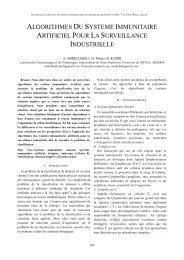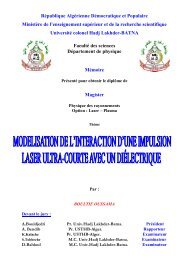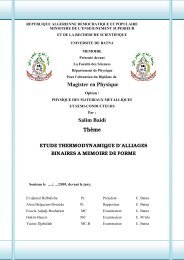Europe's Quest for the Universe - Laboratoires de Recherche
Europe's Quest for the Universe - Laboratoires de Recherche
Europe's Quest for the Universe - Laboratoires de Recherche
You also want an ePaper? Increase the reach of your titles
YUMPU automatically turns print PDFs into web optimized ePapers that Google loves.
36 Europe’s quest <strong>for</strong> <strong>the</strong> <strong>Universe</strong><br />
remaining telescopes, we find that <strong>the</strong> average cost of one clear night at <strong>the</strong>se<br />
telescopes amounts to some 13 k€.<br />
In political circles sometimes <strong>the</strong> complaint has been ma<strong>de</strong> that astronomers<br />
are good at inaugurating new telescopes, but not at closing old facilities.<br />
In fact, when a telescope is to be closed down, it will be said by many<br />
astronomers that <strong>the</strong>re is still much useful work that can be done with it.<br />
However, this misses <strong>the</strong> point. The real issues are <strong>the</strong> cost-to-benefit ratio<br />
becoming too high and could <strong>the</strong> funds nee<strong>de</strong>d to operate an ol<strong>de</strong>r telescope<br />
be used more advantageously on newer instruments. From Table II, 1 it is<br />
seen that ESO’s record in this respect is ra<strong>the</strong>r favorable. From 15 telescopes<br />
at La Silla only 5 are still operating, and that number is likely to fur<strong>the</strong>r<br />
diminish. The average lifetime of <strong>the</strong> 10 obsolete telescopes has been 25 years.<br />
ESO Operations in Chile and in Europe<br />
Coming to ESO, I found one o<strong>the</strong>r aspect that nee<strong>de</strong>d radical change,<br />
<strong>the</strong> operations in Chile. Here <strong>the</strong>re was an astronomical-technical establishment<br />
in Santiago far too separated from its raison d’être, <strong>the</strong> observatory<br />
at La Silla. Productivity in <strong>the</strong> agreeable colonial atmosphere of Santiago was<br />
not very high, and in any case it was not ESO’s role to finance an astronomical<br />
center <strong>the</strong>re. There was also too large an administrative establishment<br />
that found unnecessary roles <strong>for</strong> itself. So I <strong>de</strong>ci<strong>de</strong>d to move almost everyone<br />
to La Silla: astronomers, engineers, technicians and much of <strong>the</strong> administration,<br />
leaving only a small office in Santiago. This necessitated <strong>the</strong><br />
construction of more working and living space on <strong>the</strong> mountain and <strong>the</strong> transportation<br />
of <strong>the</strong> staff members living in Santiago or La Serena to La Silla and<br />
back at a reasonable frequency.<br />
Here <strong>the</strong> solution involved <strong>the</strong> airstrip that had been constructed <strong>for</strong><br />
emergency purposes at Pelícano, in <strong>the</strong> plain below La Silla. The astronomers<br />
in Santiago, who feared <strong>the</strong> end of <strong>the</strong>ir cozy existence, had arranged <strong>for</strong> one<br />
of <strong>the</strong>ir friends who owned an airplane to fly me to La Silla so that I could<br />
see how easy it would be to stay in Santiago and to pay visits to La Silla when<br />
nee<strong>de</strong>d. Ironically, this provi<strong>de</strong>d <strong>the</strong> solution in <strong>the</strong> opposite direction: everything<br />
could be moved to La Silla, and <strong>the</strong> required Santiago-based staff<br />
would work at La Silla on a schedule of eight consecutive days of work,<br />
followed by six days of rest at home, <strong>the</strong> transfer being ma<strong>de</strong> by air. After<br />
some initial grumbling most of <strong>the</strong> staff rapidly got used to <strong>the</strong> scheme and<br />
many found <strong>the</strong> six days vacation every two weeks a positive benefit. Thanks<br />
to <strong>the</strong> ef<strong>for</strong>ts of Peter <strong>de</strong> Jonge who managed <strong>the</strong> difficult transition phase<br />
very well, it took less than a year <strong>for</strong> <strong>the</strong> new setup to be fully implemented.<br />
The whole arrangement contributed much to <strong>the</strong> efficient functioning of<br />
La Silla, also by a much more effective interaction between engineers and<br />
astronomers. The administration now was closer to <strong>the</strong> users of its services,






